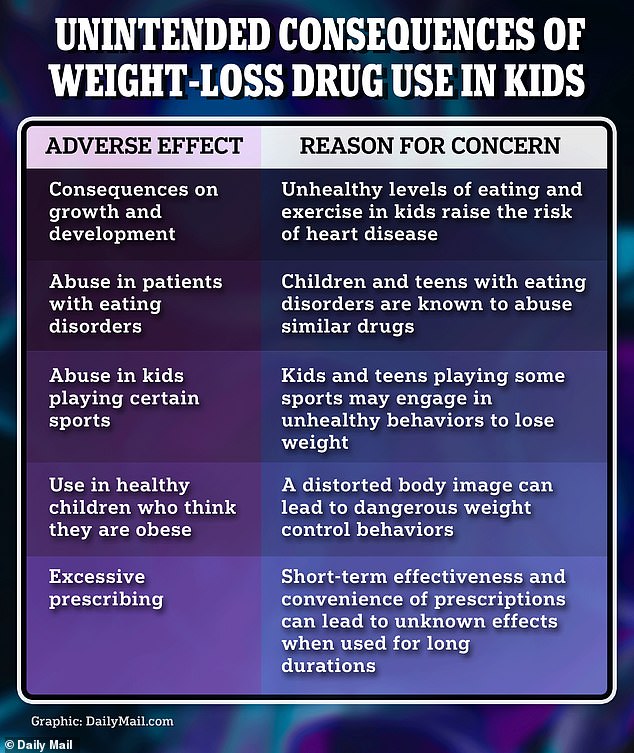One in ten young people worldwide have used duds or harmful weight loss supplements to get a toned body
In a social media-obsessed world, people are willing to go to any lengths to achieve the “perfect” Instagram or TikTok image – even if it means putting their health at risk.
And a new study shows that children are sensitive to the pressure to strive for perfection.
a meta-analysis 90 studies involving 600,000 people around the world found that the overall prevalence of adolescent use of weight-loss products is 5.5 percent.
This includes two percent of children reporting using products in the past week, four percent reporting use in the past month, six percent using the products in the past year, and nine percent of adolescents reporting using a weight-loss product in their lifetime. have used.
In the US, the overall prevalence among children is 6.1 percent.
Researchers included weight-loss medications and dietary supplements, such as diet pills, laxatives and diuretics, that were taken without a doctor’s prescription. Although studies varied based on the ages analyzed, the age of adolescence is generally considered to be between 10 and 19 years.
The study, conducted by researchers in Australia, found that use of the products was higher among girls than boys and varied from country to country.
Based on their findings, the researchers called for interventions to reduce the use of these products, which they called ineffective and harmful to long-term health.
The researchers said: ‘The high prevalence of eating and weight-related problems during childhood and adolescence is of great concern, especially as these ages include periods of rapid growth and development.
‘Disordered eating and unhealthy weight management behaviors during childhood are associated with negative psychosocial problems.
‘Additionally, unhealthy weight management behaviors can contribute to increased body weight, which can contribute to negative physical health problems.’
Across all countries included in the meta-analysis, the use of non-prescription weight loss products among adolescents was lowest in Australia, at 1.6 percent, and highest in Brazil, at 6.7 percent.
Other countries in the survey included: 2.4 percent in South Korea, 3.5 percent in Israel, 3.7 percent in New Zealand and 6.1 percent in the United States.
Among genders, almost twice as many women reported using a weight-loss product in the past week than men, 5.4 percent and 2.8 percent respectively.
In the past month, 5.8 percent of women reported using a product, compared to 3.4 percent.
In the past year, 3.3 percent of men reported using a slimming product, compared to 8.6 percent of women.
And when reporting total lifetime use, three times as many girls (9.5 percent) reported using a weight-loss product without a prescription, while only 3.2 percent of boys did so.

Previously, researchers have outlined several unintended harmful consequences that can occur in children who use weight-loss medications
The most popular weight loss product used among girls was diet pills, followed by laxatives and diuretics.
Diet pills were also most popular among boys, with laxatives and diuretics in second place.
However, diet pills and supplements carry several dangers. The products have not been approved by the Food and Drug Administration, meaning there is no way to definitively know what the pills or capsules contain.
Additionally, dozens of products have been recalled in recent years due to concerns about cancer risk and contamination with toxic ingredients.
When it comes to weight-loss products in teens, previous studies have shown that non-prescription use was associated with low self-esteem, depression and poor nutrition.
Other studies have found a link between non-prescribed use of weight-loss medications and future substance abuse.
A article published in August 2023 by researchers at the University of California, Irvine warned that drugs such as Ozempic and Wegovy have not been studied in the long term and that prescribing them to minors could pose a risk to their future health because they are still physically and mentally continually developing.
These medications activate hormones in the brain to slow digestion and keep the stomach full, reducing cravings and the risk of overeating.
The drugs were originally approved for diabetes, but doctors began using them off-label to aid in weight loss. Wegovy was approved in 2021 for the treatment of weight loss in people over 12 years of age.
In 2023, the American Academy of Pediatrics published guidelines for treating children with obesity, including the recommendation to use weight-loss medications, showing that the medications are safe and effective treatment options for children 12 years and older.
The AAP said adding these medications to a weight-loss regimen, such as changing diet and increasing physical activity, could help combat childhood obesity, which can lead to serious health problems.
The organization says obesity is one of the most common chronic diseases affecting children aged 2 to 19, affecting one in five children.
Despite this recommendation, the California researchers were particularly concerned about how the reduction in calories resulting from use of the drugs could affect children’s growth and development.
The balance between diet and physical activity in childhood influences growth and health throughout a person’s life.
With proper levels of calorie intake and physical activity, bone mineralization is increased, reducing the risk of osteoporosis and bone fractures later in life.
Any deviation from healthy eating and exercise levels can negatively impact children and adolescents as they grow, potentially leading to increased inflammation linked to heart disease, according to the researchers.
“Our greatest concern is the unbalanced and inappropriate reduction in caloric or energy intake associated with these weight loss medications,” said Dr. Dan Cooper, one of the paper’s authors and professor in the UCI Department of Pediatrics School of Medicine.
‘Unlike adults, children and adolescents need energy and sufficient calories not only for physical activity, but also for growth and development.’
